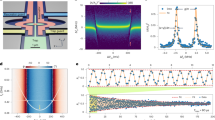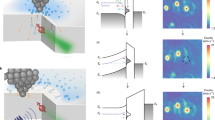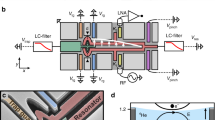Abstract
Progress towards the realization of quantum computers requires persistent advances in their constituent building blocks—qubits. Novel qubit platforms that simultaneously embody long coherence, fast operation and large scalability offer compelling advantages in the construction of quantum computers and many other quantum information systems1,2,3. Electrons, ubiquitous elementary particles of non-zero charge, spin and mass, have commonly been perceived as paradigmatic local quantum information carriers. Despite superior controllability and configurability, their practical performance as qubits through either motional or spin states depends critically on their material environment3,4,5. Here we report our experimental realization of a qubit platform based on isolated single electrons trapped on an ultraclean solid neon surface in vacuum6,7,8,9,10,11,12,13. By integrating an electron trap in a circuit quantum electrodynamics architecture14,15,16,17,18,19,20, we achieve strong coupling between the motional states of a single electron and a single microwave photon in an on-chip superconducting resonator. Qubit gate operations and dispersive readout are implemented to measure the energy relaxation time T1 of 15 μs and phase coherence time T2 over 200 ns. These results indicate that the electron-on-solid-neon qubit already performs near the state of the art for a charge qubit21.
This is a preview of subscription content, access via your institution
Access options
Access Nature and 54 other Nature Portfolio journals
Get Nature+, our best-value online-access subscription
$29.99 / 30 days
cancel any time
Subscribe to this journal
Receive 51 print issues and online access
$199.00 per year
only $3.90 per issue
Buy this article
- Purchase on Springer Link
- Instant access to full article PDF
Prices may be subject to local taxes which are calculated during checkout



Similar content being viewed by others
Data availability
The data that support the findings of this study are available from the corresponding authors on request.
Code availability
The computer codes that are used in this study are available from the corresponding authors on request.
References
Ladd, T. D. et al. Quantum computers. Nature 464, 45–53 (2010).
Popkin, G. Quest for qubits. Science 354, 1090–1093 (2016).
de Leon, N. P. et al. Materials challenges and opportunities for quantum computing hardware. Science 372, 253 (2021).
Hanson, R., Kouwenhoven, L. P., Petta, J. R., Tarucha, S. & Vandersypen, L. M. Spins in few-electron quantum dots. Rev. Mod. Phys. 79, 1217–1265 (2007).
Zwanenburg, F. A. et al. Silicon quantum electronics. Rev. Mod. Phys. 85, 961–1019 (2013).
Cole, M. W. & Cohen, M. H. Image-potential-induced surface bands in insulators. Phys. Rev. Lett. 23, 1238 (1969).
Cole, M. W. Electronic surface states of a dielectric film on a metal substrate. Phys. Rev. B 3, 4418 (1971).
Leiderer, P. Electrons at the surface of quantum systems. J. Low Temp. Phys. 87, 247–278 (1992).
Platzman, P. & Dykman, M. I. Quantum computing with electrons on liquid helium. Science 284, 1967–1969 (1999).
Smolyaninov, I. I. Electrons on solid hydrogen and solid neon surfaces. Int. J. Mod. Phys. B 15, 2075–2106 (2001).
Dykman, M. I., Platzman, P. M. & Seddighrad, P. Qubits with electrons on liquid helium. Phys. Rev. B 67, 155402 (2003).
Lyon, S. A. Spin-based quantum computing using electrons on liquid helium. Phys. Rev. A 74, 052338 (2006).
Bradbury, F. R. et al. Efficient clocked electron transfer on superuid helium. Phys. Rev. Lett. 107, 266803 (2011).
Wallraff, A. et al. Strong coupling of a single photon to a superconducting qubit using circuit quantum electrodynamics. Nature 431, 162–167 (2004).
Blais, A., Grimsmo, A. L. & Wallraff, A. Circuit quantum electrodynamics. Rev. Mod. Phys. 93, 025005 (2021).
Schuster, D. I., Fragner, A., Dykman, M. I., Lyon, S. A. & Schoelkopf, R. J. Proposal for manipulating and detecting spin and orbital states of trapped electrons on helium using cavity quantum electrodynamics. Phys. Rev. Lett. 105, 040503 (2010).
Yang, G. et al. Coupling an ensemble of electrons on superfluid helium to a superconducting circuit. Phys. Rev. X 6, 011031 (2016).
Koolstra, G., Yang, G. & Schuster, D. I. Coupling a single electron on superfluid helium to a superconducting resonator. Nat. Commun. 10, 5323 (2019).
Jin, D. Quantum electronics and optics at the interface of solid neon and superfluid helium. Quantum Sci. Technol. 5, 035003 (2020).
Clerk, A. A., Lehnert, K. W., Bertet, P., Petta, J. R. & Nakamura, Y. Hybrid quantum systems with circuit quantum electrodynamics. Nat. Phys. 16, 257–267 (2020).
Chatterjee, A. et al. Semiconductor qubits in practice. Nat. Rev. Phys. 3, 157–177 (2021).
Nakamura, Y., Pashkin, Y. A. & Tsai, J. S. Coherent control of macroscopic quantum states in a single-cooper-pair box. Nature 398, 786–788 (1999).
Schoelkopf, R. J. & Girvin, S. M. Wiring up quantum systems. Nature 451, 664–669 (2008).
Clarke, J. & Wilhelm, F. K. Superconducting quantum bits. Nature 453, 1031–1042 (2008).
Arute, F. et al. Quantum supremacy using a programmable superconducting processor. Nature 574, 505–510 (2019).
Kawakami, E. et al. Electrical control of a long-lived spin qubit in a Si/SiGe quantum dot. Nat. Nanotechnol. 9, 666–670 (2014).
Mi, X. et al. A coherent spin-photon interface in silicon. Nature 555, 599–603 (2018).
Samkharadze, N. et al. Strong spin-photon coupling in silicon. Science 359, 1123–1127 (2018).
Landig, A. J. et al. Coherent spin–photon coupling using a resonant exchange qubit. Nature 560, 179–184 (2018).
Petit, L. et al. Universal quantum logic in hot silicon qubits. Nature 580, 355–359 (2020).
Burkard, G., Gullans, M. J., Mi, X. & Petta, J. R. Superconductor-semiconductor hybrid-circuit quantum electrodynamics. Nat. Rev. Phys. 2, 129–140 (2020).
Monroe, C., Meekhof, D. M., King, B. E., Itano, W. M. & Wineland, D. J. Demonstration of a fundamental quantum logic gate. Phys. Rev. Lett. 75, 4714 (1995).
Kielpinski, D., Monroe, C. & Wineland, D. J. Architecture for a large-scale ion-trap quantum computer. Nature 417, 709–711 (2002).
Leibfried, D., Blatt, R., Monroe, C. & Wineland, D. Quantum dynamics of single trapped ions. Rev. Mod. Phys. 75, 281 (2003).
Bruzewicz, C. D., Chiaverini, J., McConnell, R. & Sage, J. M. Trapped-ion quantum computing: Progress and challenges. Appl. Phys. Rev. 6, 021314 (2019).
Pino, J. M. et al. Demonstration of the trapped-ion quantum CCD computer architecture. Nature 592, 209–213 (2021).
Brennen, G. K., Caves, C. M., Jessen, P. S. & Deutsch, I. H. Quantum logic gates in optical lattices. Phys. Rev. Lett. 82, 1060 (1999).
Jaksch, D. et al. Fast quantum gates for neutral atoms. Phys. Rev. Lett. 85, 2208 (2000).
Saffman, M., Walker, T. G. & Mølmer, K. Quantum information with Rydberg atoms. Rev. Mod. Phys. 82, 2313–2363 (2010).
Wang, Y., Kumar, A., Wu, T.-Y. & Weiss, D. S. Single-qubit gates based on targeted phase shifts in a 3D neutral atom array. Science 352, 1562–1565 (2016).
Pla, J. J. et al. A single-atom electron spin qubit in silicon. Nature 489, 541–545 (2012).
Pla, J. J. et al. High-fidelity readout and control of a nuclear spin qubit in silicon. Nature 496, 334–338 (2013).
Chen, S., Raha, M., Phenicie, C. M., Ourari, S. & Thompson, J. D. Parallel single-shot measurement and coherent control of solid-state spins below the diffraction limit. Science 370, 592–595 (2020).
Wolfowicz, G. et al. Quantum guidelines for solid-state spin defects. Nat. Rev. Mater. 6, 906–925 (2021).
Vincent, R., Klyatskaya, S., Ruben, M., Wernsdorfer, W. & Balestro, F. Electronic read-out of a single nuclear spin using a molecular spin transistor. Nature 488, 357–360 (2012).
Thiele, S. et al. Electrically driven nuclear spin resonance in single-molecule magnets. Science 344, 1135–1138 (2014).
Atzori, M. & Sessoli, R. The Second Quantum Revolution: Role and Challenges of Molecular Chemistry. J. Am. Chem. Soc. 141, 11339–11352 (2019).
Coronado, E. Molecular magnetism: from chemical design to spin control in molecules, materials and devices. Nat. Rev. Mater. 5, 87–104 (2020).
Schuster, D. I. et al. ac Stark shift and dephasing of a superconducting qubit strongly coupled to a cavity field. Phys. Rev. Lett. 94, 123602 (2005).
Wallraff, A. et al. Approaching unit visibility for control of a superconducting qubit with dispersive readout. Phys. Rev. Lett. 95, 060501 (2005).
Sheludiakov, S. et al. Electrons trapped in solid neon–hydrogen mixtures below 1 K. J. Low Temp. Phys. 195, 365–377 (2019).
Jacobsen, R. T., Penoncello, S. G. & Lemmon, E. W. In Thermodynamic Properties of Cryogenic Fluids (eds Weisend II, J. G. & Jeong S.) 31–287 (Springer, 1997).
Pollack, G. L. The solid state of rare gases. Rev. Mod. Phys. 36, 748 (1964).
Batchelder, D. N., Losee, D. L. & Simmons, R. O. Measurements of lattice constant, thermal expansion, and isothermal compressibility of neon single crystals. Phys. Rev. 162, 767 (1967).
Zavyalov, V., Smolyaninov, I., Zotova, E., Borodin, A. & Bogomolov, S. Electron states above the surfaces of solid cryodielectrics for quantum-computing.’. J. Low Temp. Phys. 138, 415–420 (2005).
Leiderer, P., Kono, K. & Rees, D. In Proc. 11th International Conference on Cryocrystals and Quantum Crystals (ed. Vasiliev, S.) 67–67 (University of Turku, 2016).
Kajita, K. A new two-dimensional electron system on the surface of solid neon. Surf. Sci. 142, 86–95 (1984).
Nilsson, A., Pettersson, L. G. & Norskov, J. Chemical Bonding at Surfaces and Interfaces (Elsevier, 2011).
Ibach, H. Physics of Surfaces and Interfaces Vol. 2006 (Springer, 2006).
Pozar, D. M. Microwave Engineering (Wiley, 2011).
Walls, D. F. & Milburn, G. J. Quantum Optics (Springer Science & Business Media, 2007).
Schuster, D. I. Circuit Quantum Electrodynamics PhD thesis, Yale Univ. (2007).
Krantz, P. et al. A quantum engineer’s guide to superconducting qubits. Appl. Phys. Rev. 6, 021318 (2019).
Ithier, G. et al. Decoherence in a superconducting quantum bit circuit. Phys. Rev. B 72, 134519 (2005).
Chen, Z. Metrology of Quantum Control and Measurement in Superconducting Qubits PhD thesis, Univ. of California Santa Barbara (2018).
Acknowledgements
This work was performed at the Center for Nanoscale Materials (CNM), a US Department of Energy Office of Science User Facility, and supported by the US Department of Energy, Office of Science, under Contract no. DE-AC02-06CH11357. D.J. and X.L. acknowledge addtional support from Argonne National Laboratory Directed Research and Development (LDRD) Program for device characterization effort. D.J. acknowledges additional support from the Julian Schwinger Foundation (JSF) for Physics Research for hardware component upgrade. This work was partially supported by the University of Chicago Materials Research Science and Engineering Center, which is funded by the National Science Foundation under award no. DMR-2011854. This work made use of the Pritzker Nanofabrication Facility of the Institute for Molecular Engineering at the University of Chicago, which receives support from SHyNE, a node of the National Science Foundations National Nanotechnology Coordinated Infrastructure (NSF NNCI-1542205). D.I.S. and B.D. acknowledge support from NSF grant no. DMR-1906003. K.W.M. acknowledges support from NSF grant no. PHY-1752844 (CAREER) and use of facilities at the Institute of Materials Science and Engineering at Washington University. W.G. acknowledges support from NSF grant no. DMR-2100790 and the National High Magnetic Field Laboratory, which is funded through the NSF Cooperative Agreement no. DMR-1644779 and the State of Florida. G.Y. acknowledges support from the National Science Foundation under Cooperative Agreement no. PHY-2019786 (the NSF AI Institute for Artificial Intelligence and Fundamental Interactions, http://iaifi.org/). D.J. thanks M. W. Cole, M. I. Dykman, S. K. Gray, P. Leiderer, D. Lopez and T. Rajh for inspiring discussions. The CNM team thanks MIT Lincoln Laboratory and Intelligence Advanced Research Projects Activity (IARPA) for providing the traveling-wave parametric amplifier (TWPA) used in this project.
Author information
Authors and Affiliations
Contributions
X. Zhou and D.J. devised the experiment and wrote the manuscript. X. Zhou performed the experiment. G.K., G.Y. and D.I.S. designed the device. G.K. and G.Y. fabricated the device. X. Zhou, X. Zhang, X.H. and D.J. built the experimental setup. B.D. simulated the device. X.L. and R.D. characterized the device. W.G. advised the sample processing and theoretical modelling. K.W.M. and D.I.S. advised the measurement and revised the manuscript. D.J. conceived the idea and led the project. All authors contributed to the manuscript.
Corresponding authors
Ethics declarations
Competing interests
Authors declare no competing interests.
Peer review
Peer review information
Nature thanks Mark Dykman, Erika Kawakami and the other, anonymous, reviewer(s) for their contribution to the peer review of this work.
Additional information
Publisher’s note Springer Nature remains neutral with regard to jurisdictional claims in published maps and institutional affiliations.
Extended data figures and tables
Extended Data Fig. 1 Cryostat and measurement setup for single-electron qubits on solid neon in a circuit quantum electrodynamics architecture.
Details are explained in the text where they are referred to.
Extended Data Fig. 2 Photographs of sample cell and electron source.
a, Lid part of the cell with all the coax connection. It contains 14 hermetic SMP feedthroughs for d.c. and RF signals, 2 SMP feedthroughs for electron source, and a stainless steel tube for neon filling. b, Pedestal part of the cell with a printed circuit board (PCB) mounted underneath a stack of copper sheets that suppress unwanted microwave modes. c, Two tungsten filaments, mounted in parallel on the back side of the lid in (a), as the electron source by thermionic emission. The inset shows a scanning electron microscopy (SEM) image of one tungsten filament.
Extended Data Fig. 3 Phase diagram of neon.
The solid-liquid-gas triple point is at (24.56 K, 0.43 bar) and the liquid-gas critical point is at (44.49 K, 27.69 bar).
Extended Data Fig. 4 Observed time evolution of transmission amplitude (A/A0)2 during the electron generation and deposition processes.
a, In the case of neon fully filling the channel. b, In the case of 5–10 nm neon coating the device. At t = 0, pulse train is sent to the tungsten filaments and electrons are generated and deposited onto the resonator. A sudden change in the spectrum can be seen. After about 3 s, the spectrum stabilizes and shows a frequency shift about 10 MHz for (a) and almost no shift for (b).
Extended Data Fig. 5 Coupling of a single electron and microwave photons.
a, Normalized transmission amplitude (A/A0)2 probed at the bare resonator frequency fr as a function of the resonator-guard voltage Vrg and the trap voltage Vt. b, Transmission phase ϕ, corresponding to the amplitude in (a), as a function of Vrg and Vt. c, Line scanned normalized amplitude (A/A0)2 and phase ϕ as a function of Vrg at Vt = 175 mV. A dip in amplitude and 2π phase jump occur when the qubit frequency matches the resonator frequency.
Extended Data Fig. 6 Vacuum Rabi splitting between a single electron and microwave photons.
a, Normalized transmission amplitude (A/A0)2 as a function of probe frequency Δfp = fp − fr and resonator-guard voltage ΔVrg (detuning from the resonance condition). b, Transmission amplitude (A/A0)2 versus a probe frequency when qubit and resonator is on resonance. The fitting curve with input-output theory gives a coupling strength g/2π about 4.5 MHz and qubit decay rate γ/2π about 3.4 MHz.
Extended Data Fig. 7 Two-tone qubit spectroscopy measurement with high pump power and pump frequency around the bare resonator frequency.
Besides the |0⟩ → |1⟩ transition line, which is marked with black dashed line, there are other transition lines visible. The line immediately next to the main transition line is the |1⟩ → |2⟩ transition. At Δ/2π = fq − fr = −100 MHz detuning, the anharmonicity α/2π ≡ f|1⟩→|2⟩ − f|0⟩→|1⟩ ≈ 40 MHz.
Extended Data Fig. 8 Calculated electron qubit properties based on a minimal model that encloses linear asymmetry and quartic anharmonicity.
a, Trapping potential V versus position y. The shape symmetrically leans to the left and right by tuning the resonator-guard voltage Vrg with respect to the ‘sweet spot’ voltage Vss = 339 mV. For Vrg > Vss, we take Vrg = 516 mV and for Vrg > Vss, we take Vrg = 162 mV, both of which are on-resonance conditions in experiment when the qubit frequency fq matches the resonator frequency fr. b–d, Electron wavefunctions on the ground state |0⟩, first excited state |1⟩, and second excited state |2⟩, respectively, for the three different Vrg’s. They extend about 500 nm in space and are left and right shifted with the potential changes. e, Qubit spectrum under frequency scanning Δfs = fs − fr and voltage Vrg detuning, for |0⟩ → |1⟩ and |1⟩ → |2⟩ transitions. The first transition (in red) matches well with the experimental observation shown in Fig. 3a. f, Magnified qubit spectrum of (e) in the ±100 MHz detuning range. The second transition has a positive anharmonicity α = 40 MHz above the first transition at −100 MHz detuning. The overall spectral profile also matches the experiment observation shown in Extended Data Fig. 7, taking account of the practical spectrum deformation due to the overly strong pumping near resonance.
Rights and permissions
About this article
Cite this article
Zhou, X., Koolstra, G., Zhang, X. et al. Single electrons on solid neon as a solid-state qubit platform. Nature 605, 46–50 (2022). https://doi.org/10.1038/s41586-022-04539-x
Received:
Accepted:
Published:
Issue Date:
DOI: https://doi.org/10.1038/s41586-022-04539-x
This article is cited by
-
Electron charge qubit with 0.1 millisecond coherence time
Nature Physics (2024)
-
A long lifetime floating on neon
Nature Physics (2024)
-
Cryogenic Resonant Amplifier for Electron-on-Helium Image Charge Readout
Journal of Low Temperature Physics (2024)
-
Cloaking a qubit in a cavity
Nature Communications (2023)
-
Observation of the Rydberg Resonance in Surface Electrons on Superfluid Helium Confined in a 4-\(\mu\)m Deep Channel
Journal of Low Temperature Physics (2022)
Comments
By submitting a comment you agree to abide by our Terms and Community Guidelines. If you find something abusive or that does not comply with our terms or guidelines please flag it as inappropriate.



